
India-Specific Outcomes: Cashless Pathways, Follow-Up Adherence, and Real-World KPIs for Clinicians
Prosthetic care in India is changing very quickly.More people are receiving quality devices, more hospitals
Buy Products, Consumables and Accessories from Robo Bionics Dismiss
Skip to content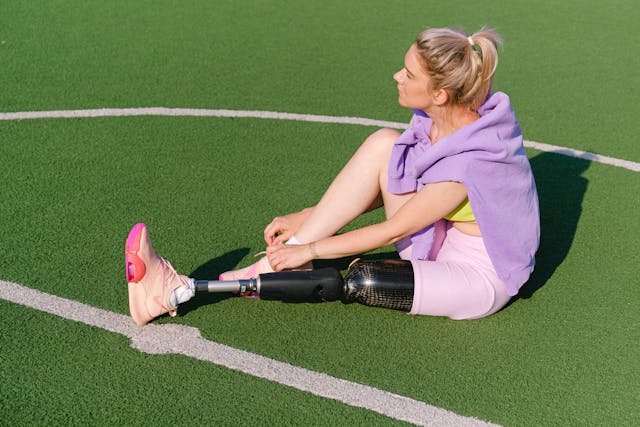
When someone loses a limb, the journey to recovery begins with more than just a prosthetic fitting—it starts with the process of learning to move again. This path is different for every person, but one thing we often see at Robobionics is that individuals with a transtibial (below-knee) amputation tend to regain mobility faster than those with a transfemoral (above-knee) amputation. The reason isn’t simply about strength or determination—it has a lot to do with how the body moves, how much of the leg is still present, and how complex the prosthetic system needs to be.
Understanding these differences can help set realistic goals, offer better support, and improve outcomes for all users. In this article, we’ll take a close look at why transtibial amputees often adapt more quickly and what makes the journey slightly more complex for transfemoral users. Whether you’re just starting your rehabilitation or guiding someone through theirs, this information will help you better understand the process and take the next step forward with clarity and confidence.
One of the biggest reasons transtibial amputees adapt faster is because they still have their natural knee joint. The knee plays a major role in balance, control, and the overall rhythm of walking.
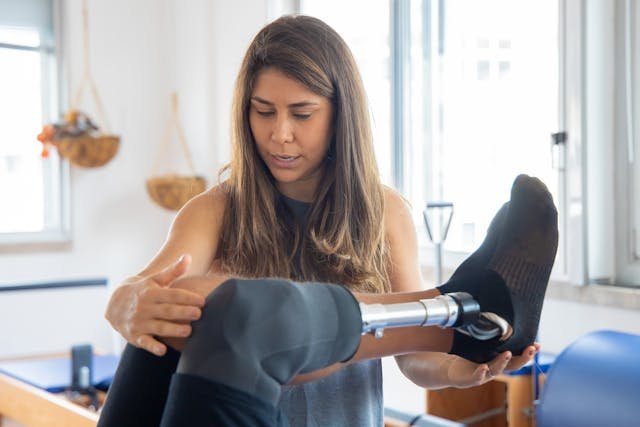
When the knee is intact, the brain and body already know how to use it. Even after an amputation, the user doesn’t need to relearn how to bend, support, or guide the leg through each step. That makes walking feel more natural, even during early prosthetic use. The body still remembers how to move with rhythm, making it easier to regain confidence quickly.
The knee helps absorb shock and adjust to changes in the walking surface. It also helps lift the foot during swing phase and control the angle during heel strike. With a functioning knee, the prosthetic foot becomes easier to control, and the user doesn’t have to rely as much on the upper body or hips for motion.
At Robobionics, we see this reflected in early rehab stages—below-knee users often walk independently within a few weeks, while above-knee users may take longer to build that same level of control and balance.
For transfemoral amputees, the loss of the knee creates an extra challenge. The prosthetic leg must now include a mechanical or electronic knee joint, which needs to be controlled by body movement. This makes walking a more conscious effort at first.
Even with advanced microprocessor knees, it takes time to learn how to shift weight, move the hip correctly, and trust the prosthetic knee to bend and support at the right moment. Many users are initially cautious or fearful, especially during slope walking or standing transitions.
Robobionics provides detailed gait training and slow step-by-step support to transfemoral users so they can build trust in their prosthetic knee. But it’s clear that adding a joint makes movement more complex, which is why the adaptation period is usually longer.
Above-knee amputees often need to learn completely new ways to move. Simple actions like sitting down, getting up from a chair, or climbing stairs all involve different muscle groups. Without the natural knee, the hips and core must do more work, and that change takes time to master.
For below-knee users, many of these movement patterns remain the same. They may need some adjustment, but the basic motion is familiar. That reduces the mental and physical strain of relearning everyday tasks, helping them adapt faster and with less frustration.
At Robobionics, we design training programs based on your specific needs. But whether you’re learning new patterns or refreshing old ones, we make sure you have the right support for every movement.
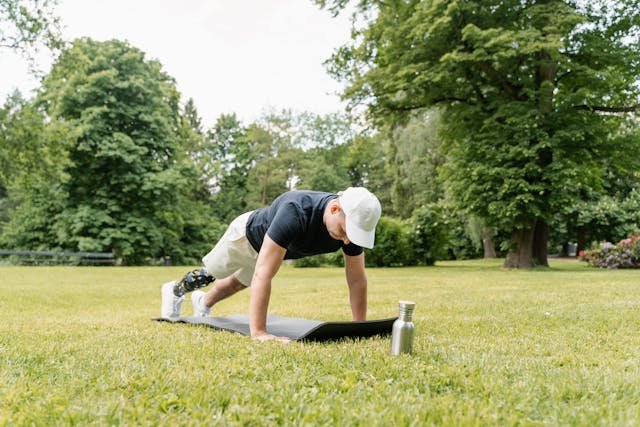
Staying balanced while standing or walking is something we often take for granted—until it becomes difficult. For prosthetic users, balance plays a key role in how quickly they regain independence.
Transtibial prosthetic users usually have a lower center of gravity because their natural knee and thigh are still in place. This helps them stay upright more easily and control shifts in body weight during movement. It also allows them to make smaller, quicker corrections when balance is lost.
This natural advantage makes it easier to perform simple tasks like standing still, reaching down, or walking around obstacles. The less energy needed for balance, the more energy can go toward walking and daily routines.
At Robobionics, we often see below-knee users become confident walkers sooner, in part because their balance feels more secure from the beginning.
For transfemoral amputees, balance depends more on the strength and coordination of the hip and core. Since the thigh is shorter and the knee is mechanical, the body’s ability to make fast, natural adjustments is reduced.
This can lead to a feeling of wobbliness or uncertainty during movement. Many above-knee users describe the early days as feeling like they have to think about every step, which adds to fatigue and slows progress.
Through targeted rehab focused on hip strength and posture, our team at Robobionics helps transfemoral users improve balance. But it’s clear that the absence of the knee joint makes this part of the journey longer and more demanding.
Balance isn’t just about physical ability—it’s also about confidence. Transtibial users, because they feel more stable early on, tend to take more steps, try new movements, and push themselves during rehab.
Transfemoral users often feel more cautious, especially if they’ve experienced a fall or instability. This hesitation is natural but can slow progress if not addressed with encouragement and proper training.
That’s why Robobionics offers structured balance training and support tools like parallel bars and safety harnesses. Building confidence in a safe environment is key to long-term mobility, especially for those using an above-knee prosthetic.
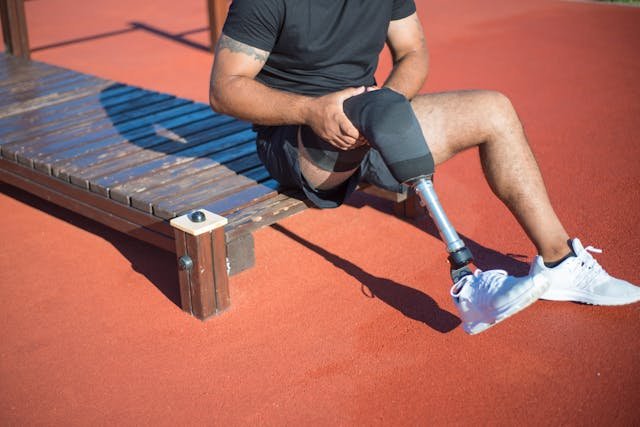
Walking with a prosthetic requires more energy than walking with two natural legs. But how much energy you use depends on the type of amputation and how your prosthesis is designed.
Since transtibial amputees retain their knee joint, their walking pattern remains closer to natural gait. The body doesn’t need to lift the leg as high or swing it as far to clear the ground. This means each step takes less effort and puts less strain on the rest of the body.
Over time, this reduced effort leads to less fatigue, fewer aches, and more willingness to walk longer distances. It also means below-knee users can return to work, travel, or daily routines with fewer physical limitations.
At Robobionics, we often hear below-knee users say they feel “almost normal” after a few weeks of training. That’s a strong sign that their energy use is well-managed by the prosthetic setup.
For transfemoral amputees, walking requires more physical compensation. The hip must lift the leg higher to move it forward, and the body must balance without help from a natural knee. This often leads to more energy use per step.
Over time, this added effort can cause fatigue in the lower back, shoulders, and sound leg. Some users develop a limp or shift their weight to avoid discomfort, which may lead to long-term joint problems if not corrected.
To reduce this, Robobionics fits transfemoral users with lightweight, energy-efficient components. We also offer advanced microprocessor knees that support better step timing and reduce the burden on the upper body.
Even with great technology, the body still has to work hard. Smart knees and dynamic feet help reduce energy use, but they can’t replace the power of trained muscles. That’s why strength training is just as important as the prosthetic itself.
Transtibial users often regain strength faster because their movements are closer to what they already know. Transfemoral users must build new strength and movement patterns from the ground up, which naturally takes more time.
Robobionics offers strength-building rehab programs that are customized for both types of users. We focus on exercises that make movement feel easier and more sustainable, no matter your starting point.
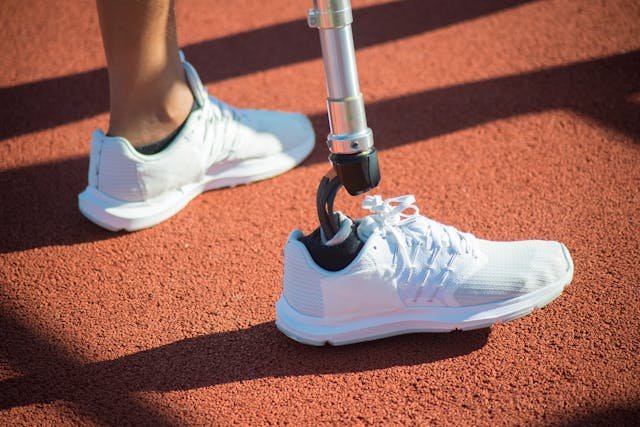
One factor that’s often overlooked in recovery is the complexity of the prosthetic itself. The more parts you have to learn, the more training it takes to use them all together smoothly.
A transtibial prosthetic typically includes a socket, pylon, and foot. That’s it. The user still has full control of their knee and thigh, so they only need to learn how to walk with a new foot. This keeps the learning curve short and the setup easier to maintain.
There’s less to program, fewer adjustments to make, and less chance for things to go wrong. This simplicity speeds up both physical and emotional adjustment. Users can focus more on walking and less on managing the prosthetic system.
Robobionics provides personalized fittings for each user, but below-knee setups usually take less time to fine-tune—allowing users to get back to life faster.
A transfemoral prosthetic includes more components: a socket, knee, pylon, and foot. The knee alone may have several settings for speed, resistance, and support. Learning how to use all these parts together takes longer—and more support from a prosthetist.
This complexity isn’t a bad thing. In fact, it allows for much better motion once the user masters it. But it does slow down the early stages of walking, especially for those who are new to using assistive technology.
That’s why we spend extra time with our transfemoral users at Robobionics. We don’t just fit the prosthetic—we train you on how to use it fully and adjust it as your movement improves.

With more components, there’s also more need for tuning and occasional repairs. A transfemoral user may need to visit the clinic more often in the first few months to make sure the knee and socket are working well together.
These visits are important, but they can slow the feeling of steady progress. In contrast, transtibial systems often require fewer follow-ups and adjustments, giving the user a smoother path forward.
At Robobionics, we reduce downtime with local repair services and remote support, so every user can keep moving with confidence—no matter how complex their prosthetic system is.
Physical differences between transtibial and transfemoral amputations are clear, but mental and emotional factors also play a big role in how quickly someone adapts. The way an individual feels about their body, their confidence, and their ability to handle change can all impact how smoothly they transition into life with a prosthetic.
For transtibial amputees, the visible change to the body is often less dramatic. Since the knee and upper leg remain intact, clothing can often cover the prosthetic, and the limb may appear more “complete” to the user. This can help ease the emotional adjustment and make the person feel more like their old self again.
This sense of familiarity supports a faster mental recovery. It’s easier to accept the prosthesis as part of the body, and users may feel more open to trying new activities, returning to work, or engaging socially without hesitation.
At Robobionics, we’ve observed that this psychological comfort contributes directly to faster progress in mobility training. When users feel more whole, they’re more likely to trust the process and take the necessary steps forward.
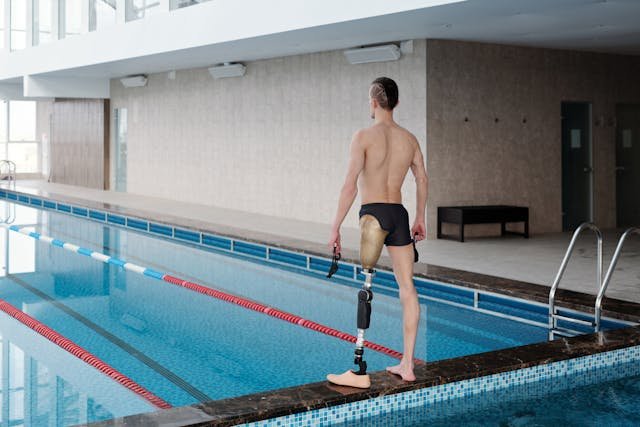
Above-knee amputees often face a more visible change in their body shape, especially when shorts or tighter clothing is worn. The prosthetic knee and thigh components can feel bulky at first, and this sometimes makes users more self-conscious about their appearance.
This emotional hurdle can slow down rehabilitation. If a user feels uncertain or embarrassed, they may hesitate to walk outside, join social events, or engage in physical activities. These delays in real-world movement limit their ability to fully adapt to the prosthetic.
That’s why Robobionics provides personalized counseling and peer support as part of our rehab programs. We help transfemoral users see that mobility is not just about how the prosthetic looks, but how it helps them live fully and independently again.
The more success someone has with their prosthetic, the more confident they become. Transtibial users often get early wins—they stand faster, walk sooner, and manage more steps with ease. These victories build confidence, which keeps motivation high.
Transfemoral users may face more ups and downs in the beginning. Progress may be slower, but every small step matters. As they start mastering balance, swing control, and knee timing, they begin to feel empowered.
At Robobionics, we track each user’s progress and celebrate every milestone. Whether it’s standing longer, walking farther, or climbing stairs independently, we make sure each success is recognized—because it’s confidence, not speed, that carries you forward in the long run.
Transtibial amputees often adapt faster than transfemoral amputees because they retain more of their natural leg, including the knee joint. This provides a simpler, more stable base for walking, requires less energy, and allows for easier balance and control. The physical system is less complex, and the mental adjustment can also feel more manageable. These combined advantages usually lead to quicker recovery and earlier independence.
That doesn’t mean the journey is easy—just more direct. Transfemoral users, though they face a longer and more involved path, can still achieve strong, confident mobility with the right training, support, and technology. Their recovery may take more time, but the results can be just as powerful, especially when guided by a dedicated team.
At Robobionics, we support both transtibial and transfemoral users with customized prosthetic systems, expert fittings, rehab tools, and emotional care. We understand that every person walks a different path—and we’re here to help you walk yours, step by step.
If you or a loved one is beginning the journey with a prosthetic, book a free demo or consultation with Robobionics today. Let’s find the right path forward—together.

Prosthetic care in India is changing very quickly.More people are receiving quality devices, more hospitals

Accepting a prosthesis is not only a physical process.It is also an emotional journey filled

Outcome dashboards are becoming one of the most important tools in modern prosthetic clinics.They help

In prosthetic rehabilitation, numbers only matter when they mean something to real people.A test score
Last updated: November 10, 2022
Thank you for shopping at Robo Bionics.
If, for any reason, You are not completely satisfied with a purchase We invite You to review our policy on refunds and returns.
The following terms are applicable for any products that You purchased with Us.
The words of which the initial letter is capitalized have meanings defined under the following conditions. The following definitions shall have the same meaning regardless of whether they appear in singular or in plural.
For the purposes of this Return and Refund Policy:
Company (referred to as either “the Company”, “Robo Bionics”, “We”, “Us” or “Our” in this Agreement) refers to Bionic Hope Private Limited, Pearl Haven, 1st Floor Kumbharwada, Manickpur Near St. Michael’s Church Vasai Road West, Palghar Maharashtra 401202.
Goods refer to the items offered for sale on the Website.
Orders mean a request by You to purchase Goods from Us.
Service refers to the Services Provided like Online Demo and Live Demo.
Website refers to Robo Bionics, accessible from https://robobionics.in
You means the individual accessing or using the Service, or the company, or other legal entity on behalf of which such individual is accessing or using the Service, as applicable.
You are entitled to cancel Your Service Bookings within 7 days without giving any reason for doing so, before completion of Delivery.
The deadline for cancelling a Service Booking is 7 days from the date on which You received the Confirmation of Service.
In order to exercise Your right of cancellation, You must inform Us of your decision by means of a clear statement. You can inform us of your decision by:
We will reimburse You no later than 7 days from the day on which We receive your request for cancellation, if above criteria is met. We will use the same means of payment as You used for the Service Booking, and You will not incur any fees for such reimbursement.
Please note in case you miss a Service Booking or Re-schedule the same we shall only entertain the request once.
In order for the Goods to be eligible for a return, please make sure that:
The following Goods cannot be returned:
We reserve the right to refuse returns of any merchandise that does not meet the above return conditions in our sole discretion.
Only regular priced Goods may be refunded by 50%. Unfortunately, Goods on sale cannot be refunded. This exclusion may not apply to You if it is not permitted by applicable law.
You are responsible for the cost and risk of returning the Goods to Us. You should send the Goods at the following:
We cannot be held responsible for Goods damaged or lost in return shipment. Therefore, We recommend an insured and trackable courier service. We are unable to issue a refund without actual receipt of the Goods or proof of received return delivery.
If you have any questions about our Returns and Refunds Policy, please contact us:
Last Updated on: 1st Jan 2021
These Terms and Conditions (“Terms”) govern Your access to and use of the website, platforms, applications, products and services (ively, the “Services”) offered by Robo Bionics® (a registered trademark of Bionic Hope Private Limited, also used as a trade name), a company incorporated under the Companies Act, 2013, having its Corporate office at Pearl Heaven Bungalow, 1st Floor, Manickpur, Kumbharwada, Vasai Road (West), Palghar – 401202, Maharashtra, India (“Company”, “We”, “Us” or “Our”). By accessing or using the Services, You (each a “User”) agree to be bound by these Terms and all applicable laws and regulations. If You do not agree with any part of these Terms, You must immediately discontinue use of the Services.
1.1 “Individual Consumer” means a natural person aged eighteen (18) years or above who registers to use Our products or Services following evaluation and prescription by a Rehabilitation Council of India (“RCI”)–registered Prosthetist.
1.2 “Entity Consumer” means a corporate organisation, nonprofit entity, CSR sponsor or other registered organisation that sponsors one or more Individual Consumers to use Our products or Services.
1.3 “Clinic” means an RCI-registered Prosthetics and Orthotics centre or Prosthetist that purchases products and Services from Us for fitment to Individual Consumers.
1.4 “Platform” means RehabConnect™, Our online marketplace by which Individual or Entity Consumers connect with Clinics in their chosen locations.
1.5 “Products” means Grippy® Bionic Hand, Grippy® Mech, BrawnBand™, WeightBand™, consumables, accessories and related hardware.
1.6 “Apps” means Our clinician-facing and end-user software applications supporting Product use and data collection.
1.7 “Impact Dashboard™” means the analytics interface provided to CSR, NGO, corporate and hospital sponsors.
1.8 “Services” includes all Products, Apps, the Platform and the Impact Dashboard.
2.1 Individual Consumers must be at least eighteen (18) years old and undergo evaluation and prescription by an RCI-registered Prosthetist prior to purchase or use of any Products or Services.
2.2 Entity Consumers must be duly registered under the laws of India and may sponsor one or more Individual Consumers.
2.3 Clinics must maintain valid RCI registration and comply with all applicable clinical and professional standards.
3.1 Robo Bionics acts solely as an intermediary connecting Users with Clinics via the Platform. We do not endorse or guarantee the quality, legality or outcomes of services rendered by any Clinic. Each Clinic is solely responsible for its professional services and compliance with applicable laws and regulations.
4.1 All content, trademarks, logos, designs and software on Our website, Apps and Platform are the exclusive property of Bionic Hope Private Limited or its licensors.
4.2 Subject to these Terms, We grant You a limited, non-exclusive, non-transferable, revocable license to use the Services for personal, non-commercial purposes.
4.3 You may not reproduce, modify, distribute, decompile, reverse engineer or create derivative works of any portion of the Services without Our prior written consent.
5.1 Limited Warranty. We warrant that Products will be free from workmanship defects under normal use as follows:
(a) Grippy™ Bionic Hand, BrawnBand® and WeightBand®: one (1) year from date of purchase, covering manufacturing defects only.
(b) Chargers and batteries: six (6) months from date of purchase.
(c) Grippy Mech™: three (3) months from date of purchase.
(d) Consumables (e.g., gloves, carry bags): no warranty.
5.2 Custom Sockets. Sockets fabricated by Clinics are covered only by the Clinic’s optional warranty and subject to physiological changes (e.g., stump volume, muscle sensitivity).
5.3 Exclusions. Warranty does not apply to damage caused by misuse, user negligence, unauthorised repairs, Acts of God, or failure to follow the Instruction Manual.
5.4 Claims. To claim warranty, You must register the Product online, provide proof of purchase, and follow the procedures set out in the Warranty Card.
5.5 Disclaimer. To the maximum extent permitted by law, all other warranties, express or implied, including merchantability and fitness for a particular purpose, are disclaimed.
6.1 We collect personal contact details, physiological evaluation data, body measurements, sensor calibration values, device usage statistics and warranty information (“User Data”).
6.2 User Data is stored on secure servers of our third-party service providers and transmitted via encrypted APIs.
6.3 By using the Services, You consent to collection, storage, processing and transfer of User Data within Our internal ecosystem and to third-party service providers for analytics, R&D and support.
6.4 We implement reasonable security measures and comply with the Information Technology Act, 2000, and Information Technology (Reasonable Security Practices and Procedures and Sensitive Personal Data or Information) Rules, 2011.
6.5 A separate Privacy Policy sets out detailed information on data processing, user rights, grievance redressal and cross-border transfers, which forms part of these Terms.
7.1 Pursuant to the Information Technology Rules, 2021, We have given the Charge of Grievance Officer to our QC Head:
- Address: Grievance Officer
- Email: support@robobionics.in
- Phone: +91-8668372127
7.2 All support tickets and grievances must be submitted exclusively via the Robo Bionics Customer Support portal at https://robobionics.freshdesk.com/.
7.3 We will acknowledge receipt of your ticket within twenty-four (24) working hours and endeavour to resolve or provide a substantive response within seventy-two (72) working hours, excluding weekends and public holidays.
8.1 Pricing. Product and Service pricing is as per quotations or purchase orders agreed in writing.
8.2 Payment. We offer (a) 100% advance payment with possible incentives or (b) stage-wise payment plans without incentives.
8.3 Refunds. No refunds, except pro-rata adjustment where an Individual Consumer is medically unfit to proceed or elects to withdraw mid-stage, in which case unused stage fees apply.
9.1 Users must follow instructions provided by RCI-registered professionals and the User Manual.
9.2 Users and Entity Consumers shall indemnify and hold Us harmless from all liabilities, claims, damages and expenses arising from misuse of the Products, failure to follow professional guidance, or violation of these Terms.
10.1 To the extent permitted by law, Our total liability for any claim arising out of or in connection with these Terms or the Services shall not exceed the aggregate amount paid by You to Us in the twelve (12) months preceding the claim.
10.2 We shall not be liable for any indirect, incidental, consequential or punitive damages, including loss of profit, data or goodwill.
11.1 Our Products are classified as “Rehabilitation Aids,” not medical devices for diagnostic purposes.
11.2 Manufactured under ISO 13485:2016 quality management and tested for electrical safety under IEC 60601-1 and IEC 60601-1-2.
11.3 Products shall only be used under prescription and supervision of RCI-registered Prosthetists, Physiotherapists or Occupational Therapists.
We do not host third-party content or hardware. Any third-party services integrated with Our Apps are subject to their own terms and privacy policies.
13.1 All intellectual property rights in the Services and User Data remain with Us or our licensors.
13.2 Users grant Us a perpetual, irrevocable, royalty-free licence to use anonymised usage data for analytics, product improvement and marketing.
14.1 We may amend these Terms at any time. Material changes shall be notified to registered Users at least thirty (30) days prior to the effective date, via email and website notice.
14.2 Continued use of the Services after the effective date constitutes acceptance of the revised Terms.
Neither party shall be liable for delay or failure to perform any obligation under these Terms due to causes beyond its reasonable control, including Acts of God, pandemics, strikes, war, terrorism or government regulations.
16.1 All disputes shall be referred to and finally resolved by arbitration under the Arbitration and Conciliation Act, 1996.
16.2 A sole arbitrator shall be appointed by Bionic Hope Private Limited or, failing agreement within thirty (30) days, by the Mumbai Centre for International Arbitration.
16.3 Seat of arbitration: Mumbai, India.
16.4 Governing law: Laws of India.
16.5 Courts at Mumbai have exclusive jurisdiction over any proceedings to enforce an arbitral award.
17.1 Severability. If any provision is held invalid or unenforceable, the remainder shall remain in full force.
17.2 Waiver. No waiver of any breach shall constitute a waiver of any subsequent breach of the same or any other provision.
17.3 Assignment. You may not assign your rights or obligations without Our prior written consent.
By accessing or using the Products and/or Services of Bionic Hope Private Limited, You acknowledge that You have read, understood and agree to be bound by these Terms and Conditions.